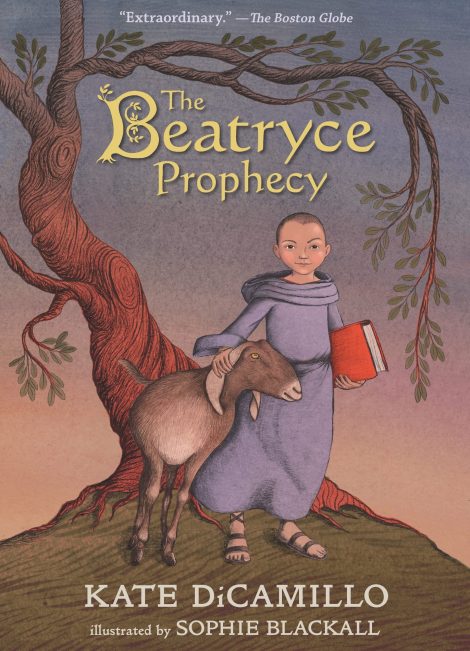
THE BEATRYCE PROPHECY
From two-time Newbery Medalist Kate DiCamillo and two-time Caldecott Medalist Sophie Blackall comes a fantastical meditation on fate, love, and the power of words to spell the world.
We shall all, in the end, be led to where we belong. We shall all, in the end, find our way home.
In a time of war, a mysterious child appears at the monastery of the Order of the Chronicles of Sorrowing. Gentle Brother Edik finds the girl, Beatryce, curled in a stall, wracked with fever, coated in dirt and blood, and holding fast to the ear of Answelica the goat.
From two-time Newbery Medalist Kate DiCamillo and two-time Caldecott Medalist Sophie Blackall comes a fantastical meditation on fate, love, and the power of words to spell the world.
We shall all, in the end, be led to where we belong. We shall all, in the end, find our way home.
In a time of war, a mysterious child appears at the monastery of the Order of the Chronicles of Sorrowing. Gentle Brother Edik finds the girl, Beatryce, curled in a stall, wracked with fever, coated in dirt and blood, and holding fast to the ear of Answelica the goat. As the monk nurses Beatryce to health, he uncovers her dangerous secret, one that imperils them all—for the king of the land seeks just such a girl, and Brother Edik, who penned the prophecy himself, knows why.
And so it is that a girl with a head full of stories—powerful tales-within-the-tale of queens and kings, mermaids and wolves—ventures into a dark wood in search of the castle of one who wishes her dead. But Beatryce knows that, should she lose her way, those who love her—a wild-eyed monk, a man who had once been king, a boy with a terrible sword, and a goat with a head as hard as stone—will never give up searching for her, and to know this is to know everything. With its timeless themes, unforgettable cast, and magical medieval setting, Kate DiCamillo’s lyrical tale, paired with resonant black-and-white illustrations by Caldecott Medalist Sophie Blackall, is a true collaboration between masters.
- Candlewick Press
- Paperback
- March 2023
- 256 Pages
- 9781536226454
About Kate DiCamillo & Sophie Blackall (Illustrator)
 Kate DiCamillo is one of America’s most revered storytellers. She is a former National Ambassador for Young People’s Literature and a two-time Newbery Medalist. Born in Philadelphia, she grew up in Florida and now lives in Minneapolis.
Kate DiCamillo is one of America’s most revered storytellers. She is a former National Ambassador for Young People’s Literature and a two-time Newbery Medalist. Born in Philadelphia, she grew up in Florida and now lives in Minneapolis.
 Sophie Blackall is a Brooklyn-based Australian illustrator of more than forty-five books for children, including the New York Times best-selling Ivy and Bean series; the 2016 Caldecott Medal winner, Finding Winnie; and the 2019 Caldecott Medal winner, Hello Lighthouse, which she also wrote. Her books have been selected for the New York Times/New York Public Library Best Illustrated Children’s Book list four times.
Sophie Blackall is a Brooklyn-based Australian illustrator of more than forty-five books for children, including the New York Times best-selling Ivy and Bean series; the 2016 Caldecott Medal winner, Finding Winnie; and the 2019 Caldecott Medal winner, Hello Lighthouse, which she also wrote. Her books have been selected for the New York Times/New York Public Library Best Illustrated Children’s Book list four times.
Praise
“The story, as well as Sophie Blackall’s lustrous pencil illustrations, lingers in the bright places of work and discovery, illumination and beauty. . . Beatryce, both the character and the book, are easy to love.” —The New York Times Book Review
“Somehow, DiCamillo manages to fit a medieval epic into just over 250 pages—and that includes many glorious black-and-white illustrations by Blackall that one can easily envision stitched upon a tapestry. It’s a gently feminist tale where stories carry the same power as magic and are, perhaps, one and the same.” —Booklist (starred review)
“The story is told in language as clear and beautiful as an illuminated manuscript, with characters who spring instantly to life. A book with an angelic soul: large, sharp, and uncompromising.”—Kirkus Reviews (starred review)
Newbery Medalist DiCamillo’s engrossing medieval fable verges on darkness while examining what changes a world. . . . Tenderly illuminated by Caldecott Medalist Blackall’s atmospheric, fine-lined b&w art, this compassionate tale rejoices in “the wonder of being known,” the protective powers of understanding one’s identity, and the strength found in the hard head of a beloved goat.” —Publishers Weekly (starred review)
“The pairing of two-time Newbery Medalist DiCamillo and two-time Caldecott Medalist Blackall is a magical alchemy.” — The Horn Book (starred review)
“Delicate illustrations and rich fairy tales run throughout the book, which stirs hope and joy at every turn.” —Foreword Reviews (starred review)
Discussion Questions
1. Based on the cover of the book, what do you predict the story will be about?
2. Looking back on the book, why did the author choose to start with Answelica? Would this indicate that the author thinks that the goat is the most important character? Who do you think is the most important character?
3. There are clues throughout the book that the counselor is evil, as Beatryce describes him on page 234. What are some of these clues?
4. Why is the counselor, and thus the king, so afraid of Beatryce?
5. The phrase “a time of war” is repeated several times in the book. Why do you think the author chose to include this phrase when the literal war was not actually very important to the plot of the story?
6. A prophecy is the basis for the plot and Beatryce’s journey. Do you think the prophecies were actually coming true? Use evidence from throughout the book to support your answer.
7. When Beatryce touches Answelica, it is like “an anchor for herself in a dark and fast-moving river” (page 85). Do you have a comfort object that helps settle you when you are feeling conflict?
8. Throughout the book, the author includes descriptions of sounds and smells, such as “He heard the buzz of a bee” (page 93). Why would the author want to include these elements?
9. Jack believes that Granny Bibspeak may have come back to life as a bee (page 93). If you could come back as an animal in a new life, what animal would you choose and why?
10. Cannoc has a tendency to find songs everywhere. Look at his songs on pages 108, 208, and 219–220. How do you think the songs sound?
11. On page 112, Jack Dory decides to lie to Cannoc because he “felt this was a situation for lying.” Do you ever think it is OK to lie? Why or why not?
12. On page 118, Beatryce lists some reasons why she trusts her companions. What are some indications to you that you can trust someone?
13. On page 123, the innkeeper’s wife says she knows nothing, but she also helps Brother Edik. Why does she act the way she does?
14. Cannoc decided to leave his spot as king. While many people strive to be famous and in power, he left it all behind. Why would he make this choice?
15. What are the differences between the two tutors described on pages 150–151, and how did their differences affect Beatryce?
16. On pages 157–158, Beatryce dreams a different dream than she has during the rest of the book. Why did her dream change?
17. How is the mermaid story (pages 205–207, 212–215, 222–224, 230–232, and 245) similar to Beatryce’s story?
18. Beatryce chooses her mom to be queen. Do you think her mom was the best choice?
19. What do you believe the theme of The Beatryce Prophecy is?
Excerpt
Answelica was a goat with teeth that were the mirror of her soul—large, sharp, and uncompromising.
One of the goat’s favorite games was to lull the monks of the Order of the Chronicles of Sorrowing into a sense of complacency by arranging her features in a benign and indifferent expression.
For weeks, she would bite no one.
When approached, she would merely stare into the distance as if she were considering something profound. And then, when the brothers had relaxed their guard, thinking that perhaps, somehow, Answelica had changed, the goat would come from behind and butt them in the backside as hard as she was able.
She was very strong, and she had a very hard head.
Because of this, the goat was able to send the monks flying great distances through the air. When they landed, she bit them. She was a goat who formed peculiar and inexplicable antipathies, taking an intense dislike to certain individuals. She would stalk a particular brother, waiting for him in the purple shadow of a building, and then she would leap out and make an unholy noise that sounded like the scream of a demon.
The monk—terrified, undone—would scream, too.
The monk and the goat would then engage in a duet of screaming until the goat was satisfied and trotted away looking beatific, leaving behind her a trembling, weeping monk.
The brothers of the Order of the Chronicles of Sorrowing would have liked to butcher her, but they were afraid of the ghost of Answelica.
The monks agreed among themselves that the ghost of the goat would surely be more vicious and determined, more impossible to outwit, than the flesh-and-blood goat.
How would she seek her revenge from the afterworld? It beggared the imagination to consider what the ghost goat would do.
And so she lived.
Which is just as well.
Which is, in fact, wonderful.
Because without the goat, Beatryce surely would have died.
And then where would we be?
